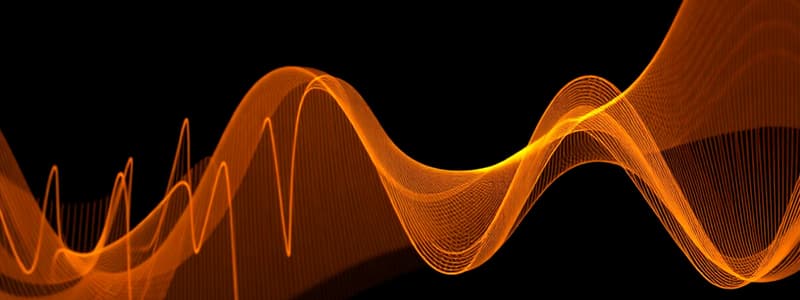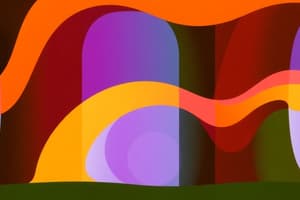Podcast
Questions and Answers
Flashcards
Financial markets
Financial markets
Markets in which funds are transferred from people who have excess funds to those with a shortage of funds.
Security
Security
A claim on the issuer's future income or assets. Can also be called a debt security.
Interest rate
Interest rate
The cost of borrowing funds, usually expressed as a percentage per year.
Fiscal policy
Fiscal policy
Signup and view all the flashcards
Foreign Exchange Market
Foreign Exchange Market
Signup and view all the flashcards
Common stock
Common stock
Signup and view all the flashcards
Study Notes
Algèbre Linéaire (Bernard Gostiaux)
- This book provides a clear and concise course in linear algebra with application exercises and problems.
- The book targets university students in scientific fields and candidates for teaching recruitment competitions.
- Numerous examples illustrate abstract concepts.
- Each chapter ends with a summary of key results.
- Topics covered include vector spaces, linear applications, matrices, determinants, linear equation systems, endomorphism reduction, Euclidean vector spaces, bilinear and quadratic forms, and affine spaces.
Fourier Transform Properties
- The Fourier Transform is a mathematical tool used to analyze the frequency components of a signal.
- $F(f)$ represents the Fourier transform of the function $f(t)$.
- These properties enable the simplification and analysis of signals in both the time and frequency domains.
Linearity
- A linear combination of functions transforms into the same linear combination of their individual transforms: $\mathcal{F}[af(t) + bg(t)] = aF(f) + bG(f)$.
Time Scaling
- Scaling in the time domain results in inverse scaling in the frequency domain: $\mathcal{F}[f(at)] = \frac{1}{|a|}F(\frac{f}{a})$.
- Compression in time implies expansion in frequency.
Time Shifting
- A shift in time corresponds to a linear phase shift in the frequency domain: $\mathcal{F}[f(t - t_0)] = e^{-j2\pi ft_0}F(f)$.
Frequency Shifting
- Multiplying by a complex exponential in the time domain shifts the spectrum in the frequency domain: $\mathcal{F}[e^{j2\pi f_0t}f(t)] = F(f - f_0)$.
- This is also called modulation.
Conjugation
- Taking the complex conjugate in the time domain flips and conjugates the spectrum: $\mathcal{F}[f^(t)] = F^(-f)$.
Convolution
- Convolution in one domain corresponds to multiplication in the other domain and vice-versa: $\mathcal{F}[f(t) * g(t)] = F(f)G(f)$ and $\mathcal{F}[f(t)g(t)] = F(f) * G(f)$.
Differentiation
- Differentiation in the time domain is equivalent to multiplication by $j2\pi f$ in the frequency domain: $\mathcal{F}[\frac{d}{dt}f(t)] = (j2\pi f)F(f)$ and $\mathcal{F}[\frac{d^n}{dt^n}f(t)] = (j2\pi f)^nF(f)$.
Integration
- Integration in the time domain involves division by $j2\pi f$ in the frequency domain and a delta function term: $\mathcal{F}[\int_{-\infty}^{t} f(\tau)d(\tau)] = \frac{1}{j2\pi f}F(f) + \frac{1}{2}F(0)\delta(f)$.
Chemical Kinetics
- Chemical kinetics studies reaction rates, how they change with conditions, and reaction mechanisms.
- It includes experiments to see how conditions influence reaction speed, yielding information on reaction mechanisms and transition states.
- Construction of mathematical models that describe a chemical reaction's characteristics are also used.
Factors Affecting Reaction Rate
- Reactant concentration: Higher concentrations often increase the reaction rate due to more frequent collisions between reactant molecules.
- Physical state and surface area: Reactions are faster when reactants are in the same phase or when there is a larger surface area of contact in heterogeneous reactions.
- Temperature: Higher temperature usually increases reaction rate by providing more energy and increasing collision frequency with sufficient energy.
- Presence of a catalyst: Catalysts speed up reactions by providing alternative pathways with lower activation energy.
- Pressure: For gaseous reactants, increasing pressure increases concentration and, therefore, the reaction rate.
- Light: Provides the activation energy for photochemical reactions.
Reaction Rate
- For the generic reaction $aA + bB \rightarrow cC + dD$, the rate is expressed as: Rate $= -\frac{1}{a}\frac{\Delta [A]}{\Delta t} = -\frac{1}{b}\frac{\Delta [B]}{\Delta t} = \frac{1}{c}\frac{\Delta [C]}{\Delta t} = \frac{1}{d}\frac{\Delta [D]}{\Delta t}$ where a, b, c, and d are stoichiometric coefficients.
- The rate is always positive and typically expressed in units of M/s (molar per second).
Rate Laws
- A rate law relates the rate to reactant and catalyst concentrations: Rate = $k[A]^m[B]^n$
- k is the rate constant, which is specific to the reaction and temperature-dependent.
- [A] and [B] are reactant concentrations.
- m and n are reaction orders with respect to A and B, determined experimentally.
- Overall Reaction Order: The sum of the individual orders (m + n).
Reaction Order
- Defines the relationship between reactant concentration and reaction rate.
- Zero Order: Rate = k (independent of reactant concentration).
- First Order: Rate = k[A] (directly proportional to [A]).
- Second Order: Rate = $k[A]^2$ or Rate = k[A][B] (proportional to the square of [A] or the product of [A] and [B]).
Teorema de Bayes (Bayes' Theorem)
- Bayes' Theorem describes the probability of an event, based on prior knowledge of conditions related to the event.
- Formula: $P(A|B) = \frac{P(B|A)P(A)}{P(B)}$.
- $P(A|B)$: Conditional probability of A given B.
- $P(B|A)$: Conditional probability of B given A.
- $P(A)$ and $P(B)$: Probabilities of A and B independently.
Deduction
- From conditional probability: $P(A|B) = \frac{P(A \cap B)}{P(B)}$ and $P(B|A) = \frac{P(B \cap A)}{P(A)}$.
- Since $P(A \cap B) = P(B \cap A)$: $P(A|B)P(B) = P(B|A)P(A)$.
- Dividing by $P(B)$ yields Bayes' Theorem: $P(A|B) = \frac{P(B|A)P(A)}{P(B)}$.
Exemplo (Example)
- Assume a rare disease affects 1 in 10,000 and a test is 99% accurate.
- $D$: Person has the disease.
- $T$: Test is positive.
- Given probabilities:
- $P(D) = \frac{1}{10000} = 0.0001$.
- $P(T|D) = 0.99$.
- $P(\neg T|\neg D) = 0.99$.
Calculation of $P(T)$
- $P(T) = P(T|D)P(D) + P(T|\neg D)P(\neg D)$.
- $P(\neg D) = 1 - 0.0001 = 0.9999$.
- $P(T|\neg D) = 1 - 0.99 = 0.01$.
- $P(T) = (0.99 \times 0.0001) + (0.01 \times 0.9999) = 0.010098$.
- Result: $P(D|T) = \frac{0.99 \times 0.0001}{0.010098} \approx 0.0098039 \approx 0.98%$.
- Even with a 99% accurate test, the likelihood of having the disease after a positive test is low because of the disease's rarity, indicating many false positives.
Descriptions spectrales des couleurs (Spectral Color Descriptions)
Stimulus de couleur (Color Stimulus)
- Light that enters the eye and causes a sensation of color.
- It can be described by its spectral power distribution (SPD), denoted as $S(\lambda)$, which dictates the amount of power for each visible wavelength ($\lambda$) between 380 nm and 780 nm.
Fonction de réflectance spectrale (Spectral Reflectance Function)
- An object's spectral reflectance function, $R(\lambda)$, indicates the proportion of light that is reflected by the object at each wavelength.
- It is defined as the ratio of light reflected to incident light.
Illuminant
- A light source categorized by its spectral power distribution (SPD), $E(\lambda)$.
- Describes the amount of light emitted per wavelength.
Calcul dy stimulus de couleur (Color Stimulus Calculation)
- The color stimulus, $C(\lambda)$, from lighting an object is the product of the illuminant and the object's spectral reflectance: $C(\lambda) = E(\lambda) \cdot R(\lambda)$.
Métamérisme (Metamerism)
- Occurs when two colors appear to match under certain lighting conditions but not others.
- SPDs of the two colors might be different, but they yield the same trichromatic response in certain scenarios.
Indice de rendu des couleurs (IRC) - (Color Rendering Index (CRI))
- Gauges the ability of a light source to reproduce object colors faithfully in comparison to a reference light source.
- A high CRI suggests the light source renders colors accurately.
Espaces colorimétriques (Color Spaces)
Espace colorimétrique CIE XYZ (CIE XYZ Color Space)
- A standard developed by the CIE (International Commission on Illumination) in 1931.
- Based on color matching functions $\bar{x}(\lambda)$, $\bar{y}(\lambda)$, and $\bar{z}(\lambda)$
- These functions represent an average human observer's response to light at various wavelengths, used to calculate tristimulus values: $X = k \int_{380}^{780} C(\lambda) \bar{x}(\lambda) d\lambda$, $Y = k \int_{380}^{780} C(\lambda) \bar{y}(\lambda) d\lambda$, and $Z = k \int_{380}^{780} C(\lambda) \bar{z}(\lambda) d\lambda$, where $Y$ is luminance and $k$ is a normalization factor.
Chromaticité CIE xy (CIE xy Chromaticity)
- Derived from the XYZ tristimulus values: $x = \frac{X}{X + Y + Z}$, $y = \frac{Y}{X + Y + Z}$.
- Defines the color.
- The CIE xy chromaticity diagram is a 2D representation of all colors.
Espace colorimétrique CIE L*a*b* (CIE L*a*b* Color Space)
- A perceptually uniform color space, developed in 1976.
- Created by transforming CIE XYZ tristimulus values
- Represents color with three coordinates: $L^$ (lightness), $a^$ (green-red), and $b^$ (blue-yellow). Calculated using: $L^ = 116 \cdot f(Y/Y_n) - 16$, $a^* = 500 \cdot [f(X/X_n) - f(Y/Y_n)]$, $b^* = 200 \cdot [f(Y/Y_n) - f(Z/Z_n)]$. With reference white tristimulus, function $f(t)$ and $f(t) = \begin{cases} t^{1/3} & \text{if } t > (6/29)^3 \ (1/3)(29/6)^2 t + 4/29 & \text{otherwise} \end{cases}$
Espace colorimétrique CIE L*C*h* (CIE L*C*h* Color Space)
- A color space related to CIE L*a*b*, using lightness ($L^*$)
- Polat Coordinatees $C^$ (chroma) is given by $C^ = \sqrt{(a^)^2 + (b^)^2}$ and $h$ (hue), $h = \arctan(\frac{b^}{a^})$
Différence de couleur (Color difference)
Formule $\Delta E^*$ (Delta E Star formula)
- Measures the color difference as the Euclidean distance between the two colors in color space.
- $\Delta E^_{ab} = \sqrt{(\Delta L^)^2 + (\Delta a^)^2 + (\Delta b^)^2}$ commonly utilized in CIE L*a*b*.
Formule $\Delta E^{*}_{00}$ (Delta E Star 00 formula)
- Is a more precise and complex calculation, factoring in lightness, chroma, and hue: $\Delta E_{00}^* = \sqrt{(\frac{\Delta L'}{k_L S_L})^2 + (\frac{\Delta C'}{k_C S_C})^2 + (\frac{\Delta H'}{k_H S_H})^2 + R_T (\frac{\Delta C'}{k_C S_C}) (\frac{\Delta H'}{k_H S_H})}$
- Considers weightings and correction parameters for perceptual effects.
Comparaison des algorithmes de tri (Comparison of Sorting Algorithms)
- Various sorting algorithms have different time complexities, which affect their performance, especially on large datasets.
Complexity Table
| Algorithm | Best Case | Average Case | Worst Case |
|---|---|---|---|
| Quicksort | $n log(n)$ | $n log(n)$ | $n^2$ |
| Merge Sort | $n log(n)$ | $n log(n)$ | $n log(n)$ |
| Heap Sort | $n log(n)$ | $n log(n)$ | $n log(n)$ |
| Insertion Sort | $n$ | $n^2$ | $n^2$ |
| Bubble Sort | $n$ | $n^2$ | $n^2$ |
| Selection Sort | $n^2$ | $n^2$ | $n^2$ |
Explanation of Algorithms
- Quicksort: A divide-and-conquer algorithm that partitions a list around a pivot element and recursively sorts the sublists.
- Merge Sort: A divide-and-conquer algorithm that divides the list into halves, sorts each half recursively, and then merges the sorted halves.
- Heap Sort: A comparison-based sorting algorithm that uses a heap data structure.
- Insertion Sort: Builds the final sorted array one item at a time by inserting elements into the correct position among those already sorted.
- Bubble Sort: Repeatedly steps through the list, compares adjacent elements, and swaps them if they are in the wrong order.
- Selection Sort: Divides the list into a sorted and unsorted part, iteratively finding the smallest element in the unsorted part and moving it to the sorted part.
Motion in Two and Three Dimensions
Position and Velocity Vector
- Position Vector: $\vec{r} = x\hat{i} + y\hat{j} + z\hat{k}$
- Displacement: $\Delta\vec{r} = \vec{r_2} - \vec{r_1} = (x_2 - x_1)\hat{i} + (y_2 - y_1)\hat{j} + (z_2 - z_1)\hat{k}$
- Average Velocity: $\vec{v}_{avg} = \frac{\Delta\vec{r}}{\Delta t} = \frac{\vec{r_2} - \vec{r_1}}{t_2 - t_1}$
- Instantaneous Velocity: $\vec{v} = \lim_{\Delta t \to 0} \frac{\Delta\vec{r}}{\Delta t} = \frac{d\vec{r}}{dt} = \frac{dx}{dt}\hat{i} + \frac{dy}{dt}\hat{j} + \frac{dz}{dt}\hat{k} = v_x\hat{i} + v_y\hat{j} + v_z\hat{k}$
Acceleration Vector
- Average Acceleration: $\vec{a}_{avg} = \frac{\vec{v_2} - \vec{v_1}}{t_2 - t_1} = \frac{\Delta\vec{v}}{\Delta t}$
- Instantaneous Acceleration: $\vec{a} = \lim_{\Delta t \to 0} \frac{\Delta\vec{v}}{\Delta t} = \frac{d\vec{v}}{dt} = \frac{dv_x}{dt}\hat{i} + \frac{dv_y}{dt}\hat{j} + \frac{dv_z}{dt}\hat{k} = a_x\hat{i} + a_y\hat{j} + a_z\hat{k}$
Projectile Motion
- Assuming $a_x = 0$ and $a_y = -g$:
- $v_x = v_{0x}$
- $v_y = v_{0y} - gt$
- $x = x_0 + v_{0x}t$
- $y = y_0 + v_{0y}t - \frac{1}{2}gt^2$
- Horizontal Range: $R = \frac{v_0^2}{g}\sin2\theta_0$
Uniform Circular Motion
- Period: $T = \frac{2\pi r}{v}$
- Radial Acceleration: $a = \frac{v^2}{r}$
- Frequency: $f = \frac{1}{T}$
Relative Motion
- Relative Positions: $\vec{r}{PA} = \vec{r}{PB} + \vec{r}_{BA}$
- Relative Velocities: $\vec{v}{PA} = \vec{v}{PB} + \vec{v}_{BA}$
Lecture 14: Channel Capacity
Channel Capacity
- The maximum rate at which information can be reliably transmitted over a channel.
- Defined as Shannon Capacity: $C = \max_{p(x)} I(X; Y)$ where the maximization is over input distributions.
Example: Noiseless Binary Channel
- Capacity is 1 bit (output is exactly the input).
Example: Noisy Channel with Non-Overlapping outputs
- Capacity is 1 bit if $p > 0$ (the receive knows the input).
Example: Noisy Typewriter
- Capacity is $log \ 26 - 1 = log \ 13$ bits (output is either the input or the next letter).
Example: Binary Symmetric Channel (BSC)
- A binary symmetric channel (BSC) channel where $C+log_{2}(1+S/N)$.
- C is the channel capacity (bits per second).
- B is the bandwidth of the channel (Hz).
- S is average receive signal power (Watts).
- N is the average noise or interference power (Watts).
- S/N os the signal to noise ratio.
Algorithmes de tri (Sorting Algorithms)
Tri par insertion (Insertion Sort)
- Principle: Iterate through the array, inserting each element into its correct position among the sorted preceding elements.
- Complexity: $O(n^2)$ (quadratic).
Example
- The list gets sorted item by item
5 2 4 6 1 3 // initial array
2 5 4 6 1 3 // insert 2 before 5
2 4 5 6 1 3 // insert 4 before 5
2 4 5 6 1 3 // 6 is already in place
1 2 4 5 6 3 // insert 1 at the beginning
1 2 3 4 5 6 // insert 3 in the middle
Tri rapide (Quicksort)
- Principle: a divide and conquer sort where sub partitions are sorted in place
- Divide: partition the list around a pivot element.
Example
> [2, 5, 8, 1, 9, 4, 7, 6, 3]
> [2, 1, 3] 4 [8, 9, 7, 6, 5]
> [1, 2, 3] 4 [5, 6, 7, 8, 9]
- Complexity: $O(n \log n)$
Tri fusion (Merge Sort)
- Principle:
- A divide and conquer algorithm, splits to sub partitions and is merged together as sorted parts.
- Complexity: $O(n \log n)$
Example
> [8, 3, 1, 7, 0, 10, 2]
> [8, 3, 1, 7] [0, 10, 2]
> [8, 3] [1, 7] [0, 10]
> [3, 8] [1, 7] [0, 10]
> [1, 3, 7, 8] [0, 2, 10]
> [0, 1, 2, 3, 7, 8, 10]
Studying That Suits You
Use AI to generate personalized quizzes and flashcards to suit your learning preferences.




